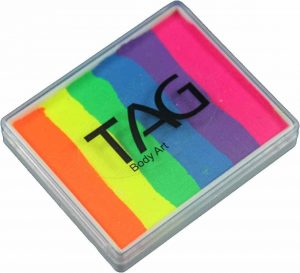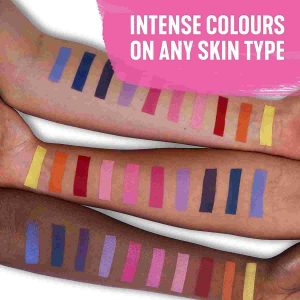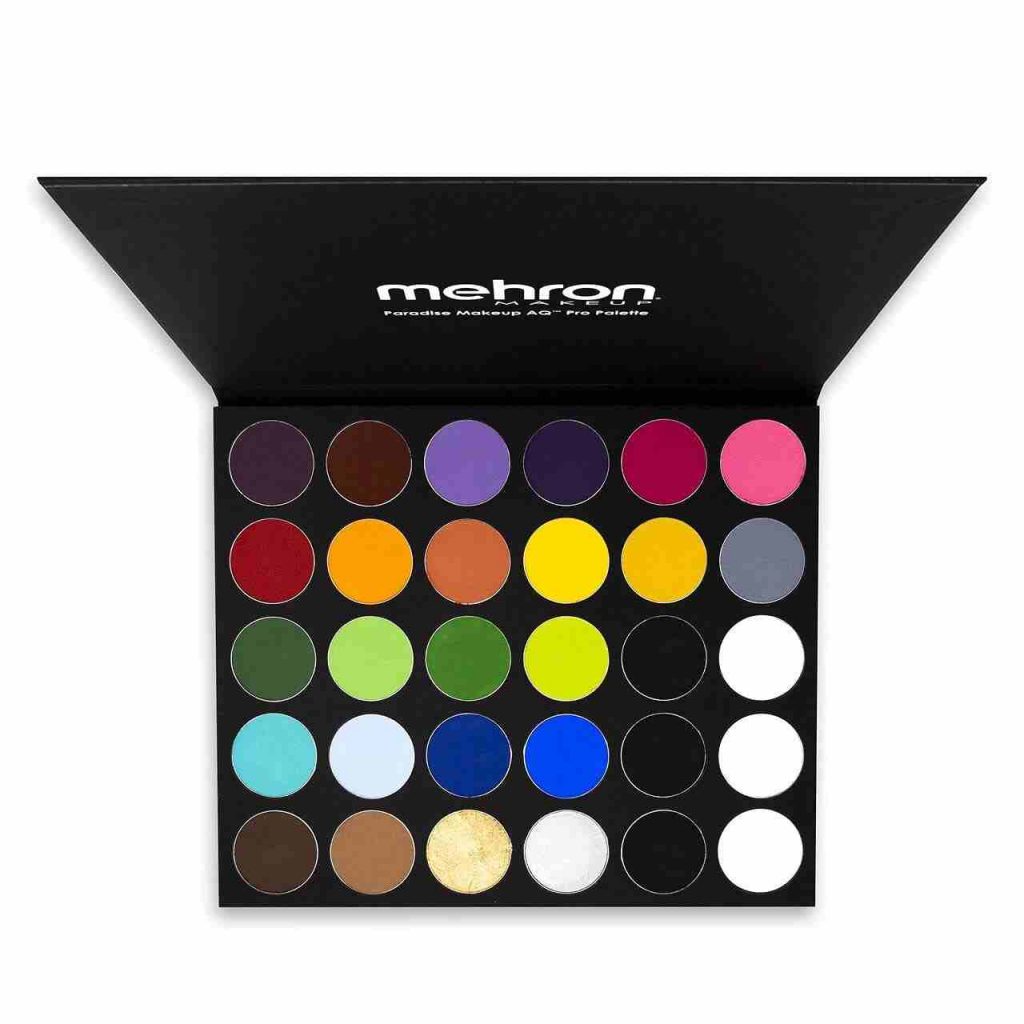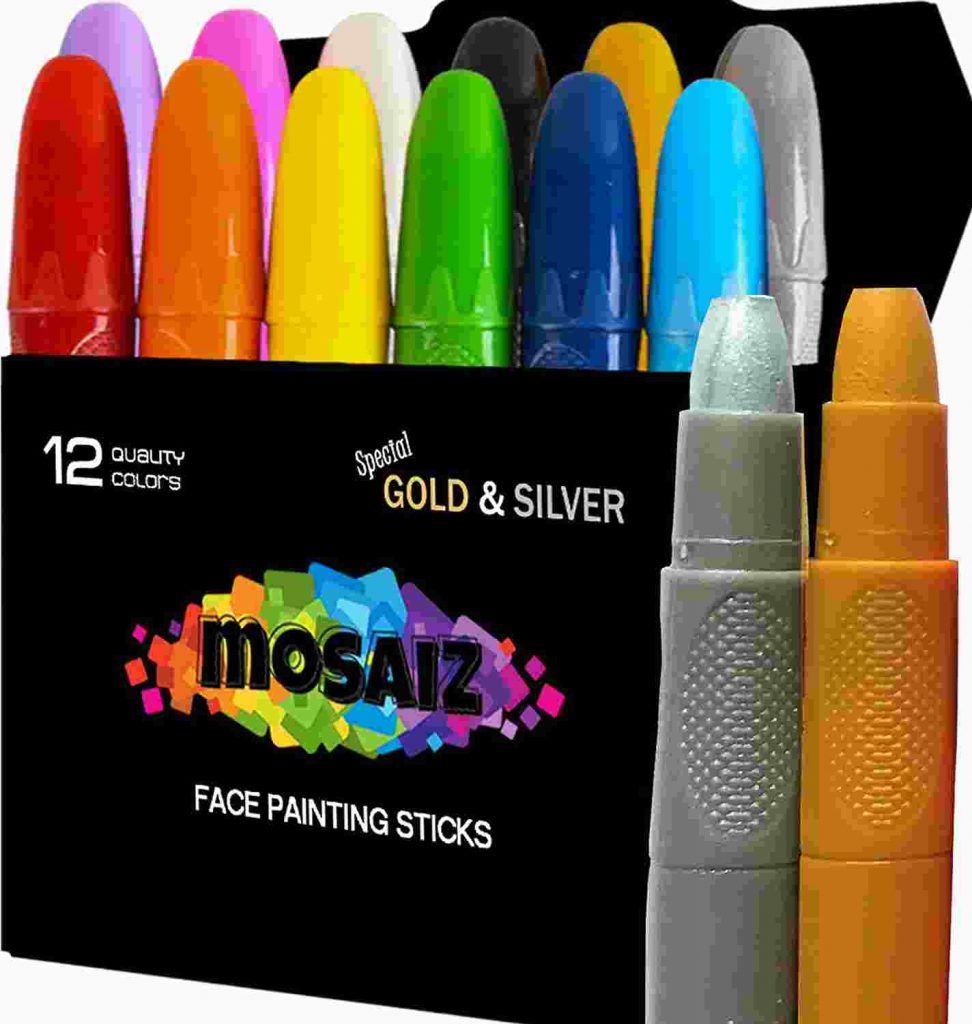Last Updated on February 10, 2024 by Masha Eretnova
If you clicked on this article, chances are you have wondered if can you put acrylic paint on your face. There are mixed opinions when it comes to this, with some saying they’re okay while others say there are toxic ingredients in them. You will find brands like Apple Barrel do not recommend putting acrylic paint on the face.
So, can you put acrylic paint on your face? Ideally, no, and that is simply because you will not know how your skin will react to the paint. Due to some ingredients in acrylic paint, you may find your face develops some allergies and not to mention, and acrylic paint is difficult to remove once they harden! Choose a special face and body paint to paint your skin safely.
Ask yourself why you would want to paint acrylic paint on your face. Is it for a Halloween party or a fun night with the children? If that is the case, there are plenty of face paints for you to choose from instead of acrylic paint.
With that being said, let’s dive deeper into this topic; hopefully, you will gain some useful knowledge from this article! And sure, we will share what paints are the best and safest to paint your face and body!
Table of Contents
Can You Put Acrylic Paint On Your Face?
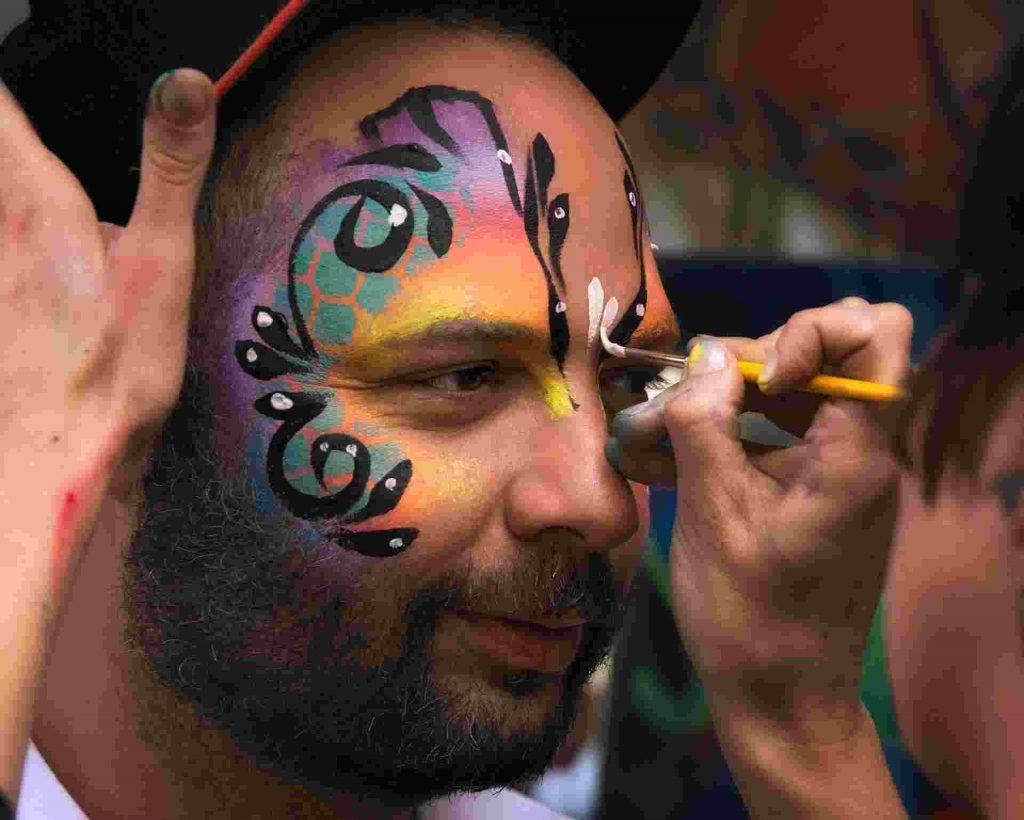
Ideally, no. You should not be putting acrylic paint on your face.
You may have heard people saying they have put acrylic paint on their face and experienced no side effects, but the truth remains that even if your acrylic paint has the label “non-toxic” on it, you should not use it on your face.
The only three chemicals that make up acrylic paint are pigment, an acrylic binder, and what is referred to as an acrylic vehicle.
The paint’s hue is a result of the pigment. Small granules that have been ground into extremely small particles and are suspended in the paint instead of dissolving gives the paint its color.
An acrylic polymer is a binder used in acrylic paint. When the paint dries, it keeps the pigment in place, and after the water in the paint has evaporated, it creates a protective coating.
The vehicle, in this case, is usually water. It transports the pigment and binder, forming an emulsion.
Now, the thing is, there are chances of you stumbling upon ingredients such as cobalt, manganese, and cadmium, among other additives in cheaper acrylic paints which may cause reactions on sensitive skin.
Whereas with face or body paints, you will find that there the absence of parabens, formaldehyde, synthetic colors, and other potentially dangerous ingredients is expressly stated on labels.
It is crucial to make informed judgments when applying any paint on your face, whether you are painting a model’s face for an upcoming photoshoot or you’re simply looking forward to throwing a face painting party for your kid.
What will happen if you put acrylic paint on your face?
Well, technically, nothing will happen because there are people using acrylic paints on their faces, be it unintentionally or purposely, and they have no side effects. But acrylics are not tested or approved for the skin.
Acrylics are not meant to be used on the face, especially if your face is sensitive. However, it is concerning when cheap paints do not clearly state their composition, so try to stick to face paints or acrylics that have the exact specifications that explain that they are suitable for use on the face.
Is It Safe To Use Acrylic Paint On Face?
No, it is not safe to use acrylic paint on the face and body, even though most acrylics are non-toxic due to the composition of the paint and possible allergic reactions.
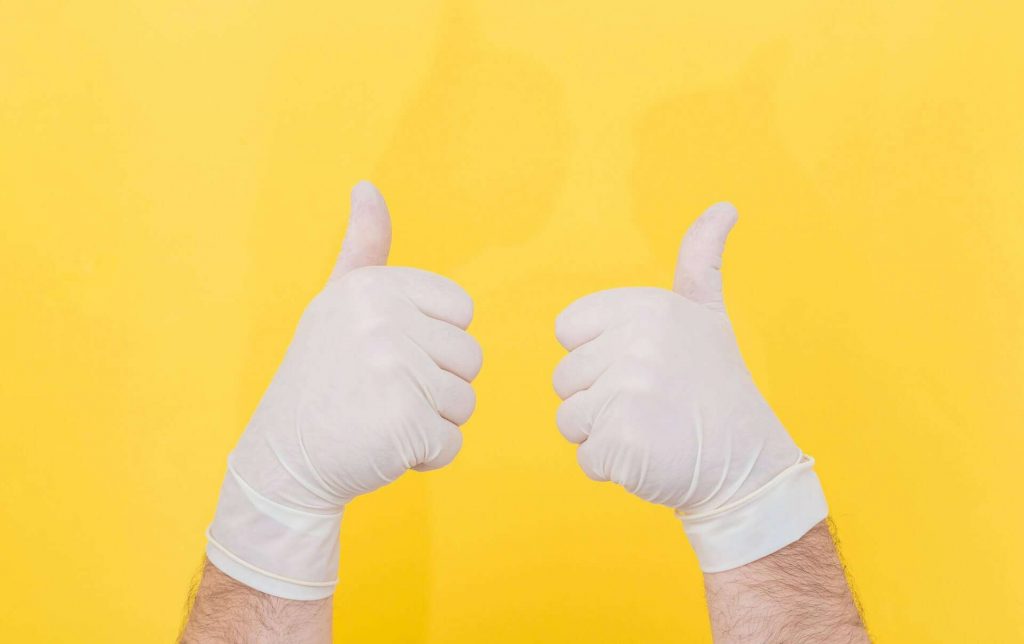
The fact that there are no pharmaceutical-certified ingredients in acrylic paints is saying something.
Even though acrylic itself is non-toxic, some of the colors can nevertheless be harmful if inhaled, consumed, or when in contact with the face.
You will be exposed to breathing in the paint’s scents because it is on your face.
According to a study in Frontiers in Public Health, at least six kinds of acrylic paint leak toxic substances into the air, especially as they dry.
Many people will disregard the cautions and continue to use acrylic paint on their faces. Lucky for them, they are the ones who would not be experiencing any breakouts or reactions. However, you should keep in mind that the chemicals are still being absorbed into your skin and body even though your face might not exhibit any symptoms.
Acrylic painting is chosen for many art pieces because it hardens up fairly quickly and the paint lasts for a good time with proper care. But it is not the best choice for face and body art painting.
There is another reason why you should not use acrylic paint on the face: it will dry quickly, and you will have a hard time washing the paint off. While your face or body will move, acrylics will peel off or crack.
On top of having an allergic reaction or rashes form from using acrylic paint, the process of removing them will be a painful one that may cause even further damage to our soft and supple skin.
You do not want to come for a face painting party only to find yourself with a red face, pimples, or rashes forming all over.
Can you put acrylic paint on your face for a day?
When acrylic paint is used on human skin, there is no acceptable minimum exposure period. Varieties of acrylic paints can cause strong reactions, moderate or no reaction at all in certain people.
All forms of artists’ paints are not formulated with cosmetic-grade pigments and weren’t designed to be applied to the skin. Some items used in the cosmetics and special effects industries include acrylic bases that have passed FDA testing and have been allowed for use on skin.
It is nevertheless strongly advised to use specifically made face paint to avoid any potential irritation or reactions from using acrylic paints on the face.
Read also: Best Edible Markers for Cookies Decoration [Buyers Guide]
What Kind Of Paint Can You Use On Your Face And Skin?
Before deciding on the best paint to use for your face and skin, let’s look at the common types of paint out there that are commonly used for the face and skin.
1. Water-Based Paint
Many of the water-based paints on the market today are tightly controlled and must adhere to a stringent set of rules in order to be approved. Kids can use it with ease because it is non-toxic and simple to remove after usage.
This kind of paint can be applied with a variety of tools. Got a Halloween party? Get your brushes out and paint away. Having a fun face painting night? Use your hands and get messy!
You get the point. You can go wild with these kinds of paint.
2. Alcohol-Based Paint
You know those cool special effects makeup that knocks your socks off?
Yeah, this is where alcohol-based paints come in. This kind of body paint is typically applied for special effects or to create airbrush tattoos. It works best for body painting underwater or in hot, sunny locations, and sweat won’t cause alcohol-based paints to crack or flake because they are waterproof.
One thing to bear in mind is that this type of paint may not come off easily, and you may have to use rubbing alcohol to remove them. As you wash the paint off your skin, you might have to wait for a day or so, providing your skin to recover from being applied with rubbing alcohol.
3. Metallic Paint
Have you stumbled upon men in silver or gold? They seem to be covered head to toe in silver and gold paint, have you wondered how that is done?
This is where metallic paint comes in. The person probably employed this kind of body paint to give himself that shiny, glossy appearance. Real metal powder mixed with a unique liquid is used for metallic body paints to provide the “statue” impression.
However, because they include metal powder, these paints are known to irritate the skin and should be used with caution. Additionally, it is more difficult to remove than water-based paint. Simply avoid using it unless you absolutely must for performance.
4. Oil-based paints
Many good quality face paints are oil-based paints but not the same as oil paint we use for canvases! Regular oils same as regular acrylics are not safe to use on the skin. Face oil paint is usually very creamy, allowing them to stay flexible while the skin is moving.
Safe oil-based paint for face and body paints are CC Beauty and hypoallergenic UCANBE face and body paint.
5. Henna
Henna is the oldest natural pigment people use to dye hair and skin. It is relatively safe to use on the skin, both face, and body. Black henna may cause reactions, so please test before painting. In some countries, henna is mostly used on hands for decoration or special ceremonies. Be aware that henna sticks to the skin for a few weeks once dried!
Some girls also use henna to make freckles or temporary tattoos. Isn’t it amazing?
The downside of henna is that due to the nature of the pigment, there is no such variety of colors as we have with water-based face paint.
6. Latex Body Paint

Latex paint is mostly used to cover the whole body or large areas, and not really good for the face as face painting requires more details and less paint, actually. The finish looks glossy just like latex and offer great coverage.
Liquid Latex Fashions produce a large variety of body paint for Halloween and full-body costume painting.
Best Safest Face and Body Paint for Halloween, Cosplay, and Kids
- Natural Face Paint – the best eco-friendly paint with no chemicals and harmful ingredients. Safest paint to use on the market.
- Snazaroo Classic Face Paint – fits any skin color
- Mehron Makeup Paradise AQ Magnetic & Refillable 30 Color Pro Paint Palette – Best for pro cosplay and make up artists.
1. TAG Split Cakes – Neon Rainbows
The TAG split cake is made to paint colorful designs easily and rapidly. There are 6 colors available for it – red, yellow, green, blue, purple, and pink. You can create your own design by using these 6 primary colors.
The ingredients that make up this paint are non-toxic and safe.
It is a water-based paint; you only need some water to activate it before you start painting your face or skin. Face paint can be removed with water, soap, or a damp cloth.
On the professional face painting marketplace, TAG is available in pearl, neon, regular colors and cakes. For the best choice browse the selection here: TAG Face Paint.
Main Features
- excellent paint with rich, opaque colors that are brilliant.
- It’s simple to use since, when used properly, you can quickly create patterns.
- The skin doesn’t itch or feel uncomfortable after using the product.
- Without touching up, it can stay on the face for hours.
- There is a tonne of paint in the container.
2. Snazaroo Classic Face Paint – Great for any skin color!
The FDA rules and regulations are followed in producing this body paint from Snazaroo, and a qualified outsider always examines it. Since this body paint is non-toxic and fragrance-free, it is excellent for people with sensitive skin.
This set’s colors are vivid and opaque so they will complement any skin tone. There are 36 colors available! Since it is water-based, a little water is all you need to activate it.
The colors dry rapidly, making them perfect for use on children at birthday celebrations and other special occasions. Additionally, it can remain on the skin for hours without irritating it. This body paint is simple to remove with washing and water.
Main Features
- If you avoid humidity after applying it, it doesn’t smear much.
- Long wear time is possible with no breaking or fading while it is on the skin.
- The product has a long shelf life in just one container.
- When using it as face paint, you may easily layer makeup over it.
3. Mehron Makeup Paradise AQ Magnetic & Refillable 30 Color Pro Paint Palette – Best for Pro Make-up artists and cosplay.
All FDA requirements and standards were followed as the product was produced in the USA. This paint palette is also vegan and cruelty-free. You may create some stunning body paint designs with this set’s water-activated paints.
Water can also be used to modify the colors’ translucency. Even after repeated uses, this paint set is quite gentle on the skin. It doesn’t irritate it, as it contains additional ingredients such as Aloe, Avocado, Cucumber, and Vitamin E. Additionally, it dries rapidly without being very sticky.
Main Features
- The paint set offers 30 vivid, highly pigmented, and blending-friendly colors.
- The set is well-stocked with paint and is durable, but it also super easy to refill
- The box includes a mirror for touch-ups while you’re on the go, and the packaging is excellent.
- To wash it off, just use soap and water.
- Perfect for make-up artists who work on photoshoots, cosplayers, and artists, as all pigment pans are magnetic!
4. Mosaiz Face Paint Sticks
The broad-tipped paint sticks are safe and simple for children to use, and because the crayon face and body paints may be twisted, they can’t be broken easily. For consistent paint strokes, the ergonomic form of Mosaiz crayons offers the ideal compromise between balance and comfort.
The palette is perfect for people with sensitive skin because the colors are skin-friendly, food-grade pigmented, and contain components that are safe for the skin.
The cosmetic colors dry quickly and are simple to wash and remove with warm water and mild soap. The Face Painting Set has been dermatological tested, is paraben-free, and complies with ASTMD-4236.
Main Features
- It’s a high-quality paint that doesn’t fracture after drying and dries rapidly.
- The bold hues work well together to create some amazing artwork.
- It is gentle on the skin and easily removed.
- Made up of safe ingredients.
5. Glow In The Dark Body Paint
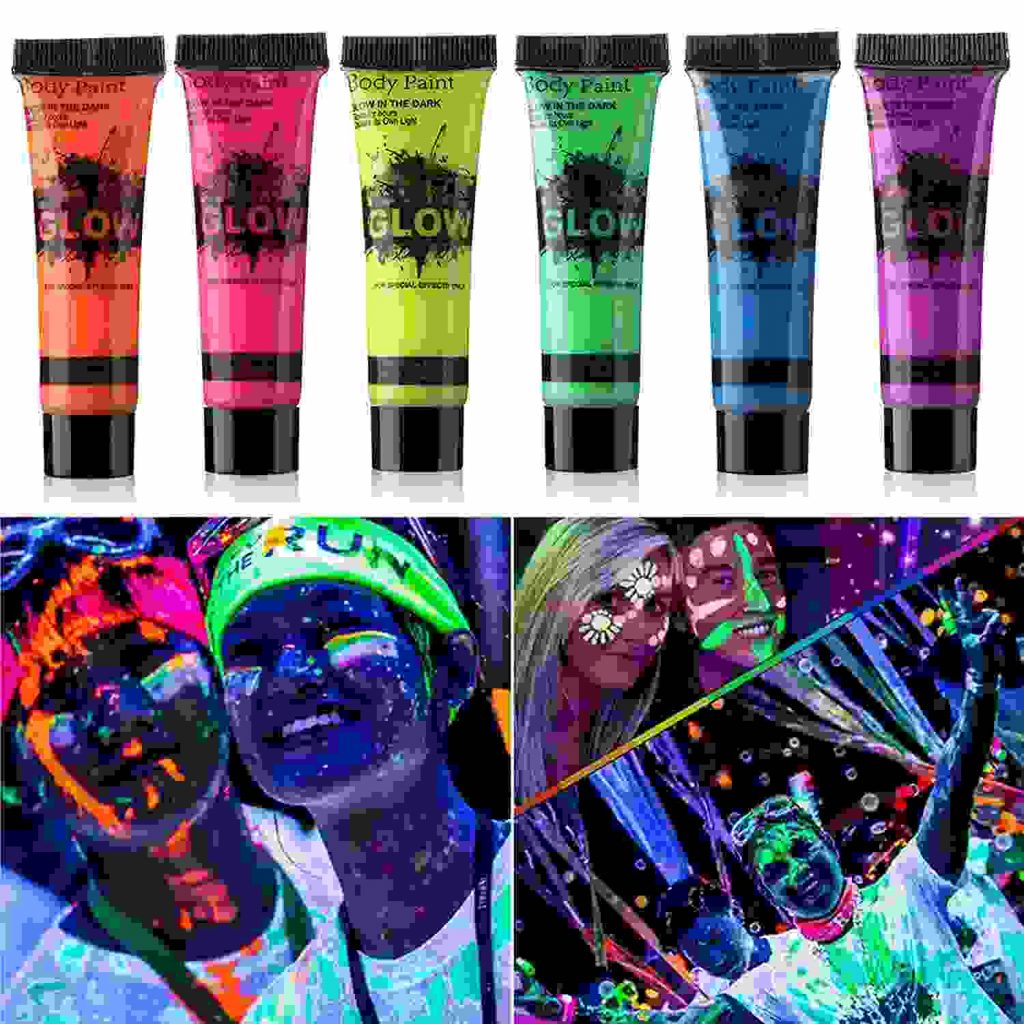
The phrase exposure to blacklight or UV light should be highlighted since this is the only method for the paint to glow. The neon light body paint has been thoroughly examined for hazardous ingredients and is ASTMD-4236 approved, making it safe to use.
Once applied, the paint dries rapidly and can remain on the skin for several hours without causing any irritation. The colors in this set are simple to remove off clothing after usage and don’t appear to leave stains.
Main Features
- When exposed to UV or black light, it lights brilliantly.
- The bottles contain plenty of paint for many individuals (up to 20).
- It continues to last for a very long time.
- The paint doesn’t irritate and is simple to wash off.
- Clothes are not stained by the paint.
6 – Natural Earth Face Paint – The safest face paint!
Earth Paints have a great mission and they produce all kinds of art supplies using sustainable methods with no harm to humans or nature. This face paint doesn’t contain any chemicals or bad ingredients and absolutely safe for kids and adults’ faces.
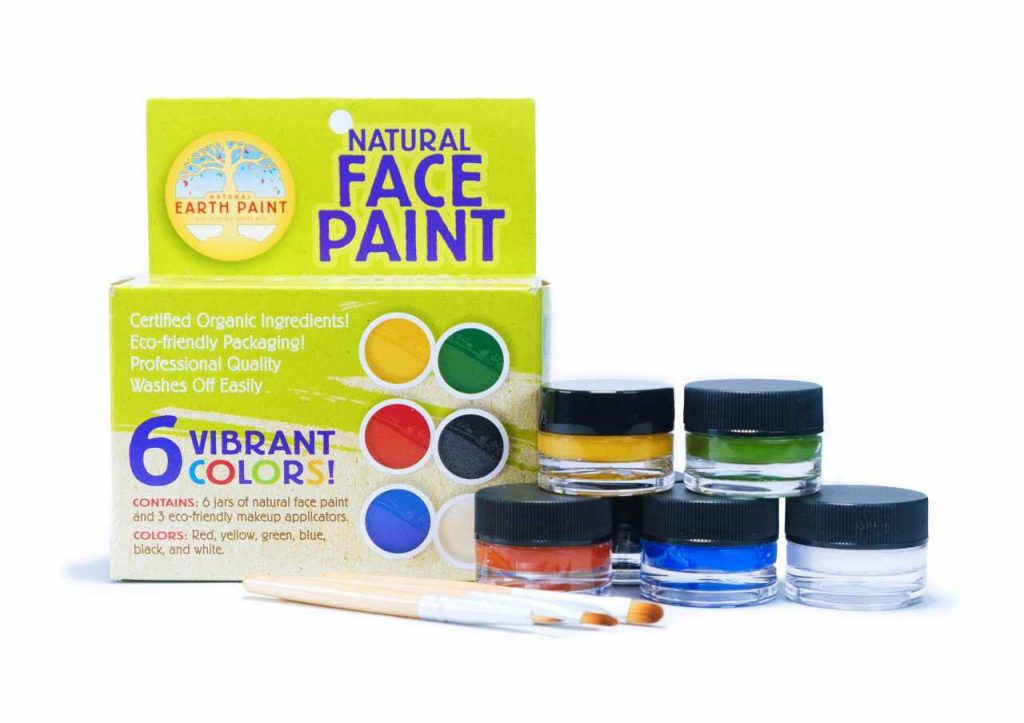
Pros:
- clay and mineral-based paint
- Shea butter in its composition protects your face skin
- Easy to wash off with just water
- Excellent colors
- No heavy metal, no parabens, no formaldehyde and other chemicals or fumes
- 6 colors included: Red, Yellow, Green, Blue, Black, and White
- Sustainable eco-friendly bamboo applicators are also included.
Read also: Best Paint for Eva Foam: 5 Flexible Paints For Cosplay & Crafts
Can You Use Acrylic Paint On Skin?
I’m sorry if the answer seems to be coming off a broken record, but ideally, no. Avoid using acrylic craft paints on the face and other exposed body parts. Many of the pigments in acrylic paints are dangerous to use on the skin and can seriously irritate it.
Can You Use Acrylic Paint On Baby Skin?

You should not put acrylic paint on baby skin. As mentioned above, the chemicals in acrylic paint are likely to be absorbed into the skin, and that is probably the last thing you would want for your baby.
Unfortunately, the manufacturers of the majority of commonly used art supplies contain potentially harmful substances and chemicals. But tons of face, body paint, and crayons are safe to use on kids’ skin!
Here are some tips the next time you buy baby paint supplies:
- Choose water-based paints and other creative supplies over oil-based ones.
- Look for paints that use natural pigments extracted from plants or minerals or baby-safe crayons.
- Read the labels. It often says from what age you can apply the paint. Ex., this Dress Up America Face Paint is safe to use from the age of 3.
Can You Put Acrylic Paint On Your Hands?
Any portion of your body, including your hands, should not be painted with acrylic paint. Never paint your hands with acrylic paint or use it on your child’s hands for creative projects.
However, don’t panic if you accidentally get messy with acrylics doing pouring or painting (it happens all the time during pouring, y’all know! You tilt the canvas, and all paint drips on your hands, or during painting, want it or not, the paint will be everywhere, lol).
If you wash it off immediately, you will be fine. But if you have preexistent skin conditions or just like everything to be clean, use gloves. If possible, use compostable gloves to help our planet.
How To Make Acrylic Paint Safe For The Skin?
There is a way to turn acrylic paint into face paint because it is so flexible. I advise you to take the actions listed below to prevent any unwanted skin reactions.
You will need 3 items:
- acrylic paint (better to choose well-known brands with detailed descriptions and non-toxic acrylic paints)
- Lotion of some sort.
- Setting spray.
After having these two supplies, you can use acrylic paint to create face paint. Follow these quick and easy steps, and you are good to go!
Prepare face acrylic paint:
- The acrylic paint must first be squeezed onto your palette.
- Then, using a mixing brush, apply the lotion or moisturizer to the color of your choosing until it is thoroughly blended. The ratio is 1:1. Make sure your face skin doesn’t have an allergic reaction to the lotion, or it is not too heavy for it (especially if you have oily skin)
- Protect your skin with a regular setting spray.
- You can now paint your face with this concoction!
An extra tip would be to create a thin barrier between your skin and the face paint; you could choose to moisturize your face first. Remember that acrylic paint may crack if exposed to your skin for an extended period and may require touch-ups.
How To Safely Paint Face Or Body In 3 Simple Steps
Once you have gotten yourself some good quality face or body paint, you can start to paint them safely in these three steps.

Supplies to paint face or body:
- Body paint
- Clean brushes (some face painting sets also come with brushes)
- Clean sponges (please use a separate one with body paint, not the one you use for makeup).
- Tissues
- Wet wipes
- Glitter and gems are optional but look absolutely gorgeous and worth trying!
- Stickers
- Stencils (easy to apply to paint butterflies, ornaments, and patterns)
Step 1: Gather Your Tools and Test the Paint on Skin
Choosing the correct products, in the beginning, is essential. Use only cosmetic-grade items that adhere to the rules in your country. We advise only using face paints that adhere to FDA regulations in the USA.
Before applying any face paint, do a patch test to see if it is suitable for your skin. Sanitize a small area on your wrist and apply the paint. Wait for 15 – 20 minutes to see if there are any reactions occur.
Along with face and body paints, you’ll also need some extra items, such as brushes or sponges. Water and wet wipes may also be necessary for removing spills as you go along.
Should you choose to add your own flair to the finished work, have items like glitters or stencils to aid in your craft.
Step 2: Prep The Skin
Clean skin is important when it comes to skin painting.
Offer a baby wipe so the individual getting painted can clean themselves if their face is unclean or the area you are painting over is dirty. By doing so, you’ll be able to prevent contaminating your equipment, which could then contaminate your paints.
The lasting you need is breakouts after the face painting session.
Step 3: Start Painting
Here comes the best part!
Now that you have gotten the first two steps down, there is no wrong way for you to paint! Paint to your heart’s desires, and try out different shapes and patterns to get the desired outcome. If you are not comfortable with doing it free-hand or your kids are playing with face painting, grab some stickers and stencils to create perfect paintings 🙂
How To Wash Off/Remove Acrylic Paint From The Face And Body
Since regular acrylic paint is water-based, it is pretty simple to remove acrylic paint while wet. Due to its tendency to solidify after touching skin, acrylic paint can also be challenging to remove.
However, here are some simple ways for you to try.
1. Wash With Soap And Water.
The first thing you can do to rid your skin of acrylic paint is to wash it off with soap and water while the paint is still wet. When the paint is wet, removing them is less difficult than when they are dry.
Try scraping the pain without putting much force on your skin so as not to irritate your skin or cause any inflammation.
2. Baby Wipes
A pack of baby wipes sometimes does the trick to remove acrylic paint from your skin. Once again, the trick is to use the baby wipes and remove the paint quickly.
Gently wipe the baby wipes across the exposed areas of your skin to safely remove the acrylic paint. This is a rather inexpensive method compared to some options and helps you get off the acrylic paints.
3. Natural Remedies
If water and baby wipes did not do the trick, you could try getting the paint off with these options below:
- Any form of vegetable oil
- Baby oil
- Butter or margarine
- Mayonnaise
- Vaseline or petroleum jelly
4. Peel It Off
The least favorable option is to peel the paint off once it dries.
Ever known what it is like to be waxed? If yes, then this is what it will feel like.
Peeling off the paint from your skin will be the most painful option and will highly likely cause irritation and inflammation to your skin. However, this is probably the only option that may work if the paint has completely dried and has started to crack.
This is why, when you get acrylic paint on your skin, it is best to react fast and work towards removing the paint.
FAQ Section
Can You Put Apple Barrel Acrylic Paint On Your Face?
No, because Apple Barrel acrylic paint does not have FDA approval to be painted on the face.
Just like any other acrylic paints, it is not recommended to apply acrylic paints on the face as they are not formulated with any pharmaceutical-grade ingredients that make them safe to be put on the face.
Can You Put Matte Acrylic Paint On Your Face?
No.
You shouldn’t apply acrylic paint on your face. It might not be harmful, but acrylic paint pigments can seriously irritate and harm the skin. We advise choosing a product made especially for face painting if you wish to paint your face.
Can You Use Acrylic Paint As Makeup?
No, you can’t.
There is an unlimited amount of makeup items for you; do not opt for acrylic paint as makeup. It will not give you the desired look you’re going for. As mentioned earlier, there are plenty of face paint options like the ones from popular Tag Body Art or Mehron, so use that instead.
Will Acrylic Paint Wash Off Skin?
Yes. If you try to wash off acrylic paint quickly while it is wet, chances are the paint will come off.
Once the paint dries up and hardens, you will have difficulty removing them.
Wrap Up
At the end of the day, acrylic paints were never intended to be applied to the skin. They can include harmful compounds, have a tendency to solidify on the skin, and are challenging to remove when it dries up.
It may cause skin irritation and is not suggested to be used as face or body paint, depending on the individual. Therefore, it is better to stay away from using acrylic paints on the skin in favor of water-based, non-toxic alternatives that are created with skincare in mind.

Masha Eretnova, born in 1991, is a Buenos Aires-based certified teacher, artist, and member of the Professional Artist Association with 20+ years of personal painting journey.
She started painting and drawing very early and is now an international abstract artist and educator passionate about acrylic painting, gouache, and crafts.
Her works are part of international exhibitions and contests, including ArtlyMix (Brazil), Al-Tiba 9 (Spain), Exhibizone (Canada), Italy, and many more.
Besides her artistic pursuits, Masha holds a post-grad diploma in Teaching Film Photography and 2 music school diplomas: piano and opera singing.

